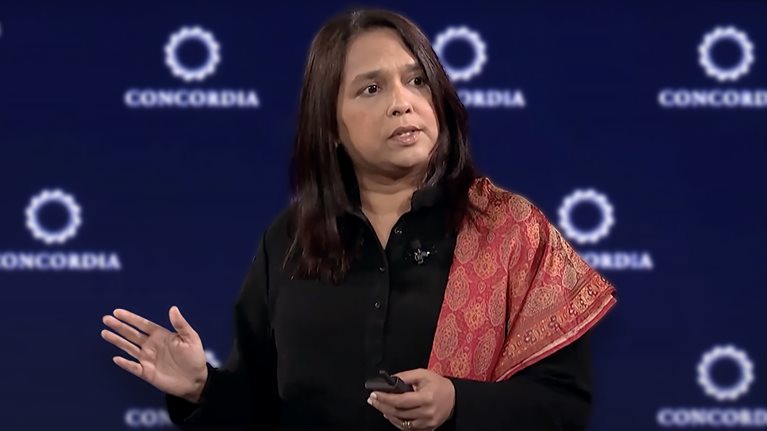Leaders face two generational opportunities: getting to net-zero emissions and reducing global poverty. “This year, a number of them expressed their belief that we should not have to choose between fighting for the planet and fighting poverty,” says Anu Madgavkar, a McKinsey Global Institute (MGI) partner. “A similar conviction has underpinned our research.”
In MGI's new report, From poverty to empowerment: raising the bar for sustainable and inclusive growth, the authors show how these urgent issues are interconnected, and detail how thoughtful growth can lead to both a better quality of life and a greener world.
The research was presented at the B20 Summit in India and at meetings during the UN General Assembly Week in New York City. We recently talked to Anu and Mekala Krishnan, also an MGI partner, both of whom led the research.
What does it mean that growth, inclusion, and sustainability are interconnected as one ‘system’?

Mekala: Simply put, it means that solving one of the problems in isolation risks hurting the others. Solving them together can help advance all three simultaneously, if managed well.
For example, if we talk about increasing incomes, it allows people to buy a whole range of goods. They may buy their first vehicle, say a motor bike; move to a bigger apartment or home; gain access to things like education and health care; and maybe have less of an emissions footprint. But many aspects of their consumption actually could, if not well-managed, raise their overall emissions footprint.
On the other hand, raising incomes also allows people to afford more expensive items, such as electric vehicles, that they may not be able to afford otherwise. If it is well-managed, we can actually reduce emissions, because we have the financial means to make some of the energy transition investments that we need to make.
What can private and public sector leaders do to encourage the growth needed to advance these twin agendas?

Anu: For the private sector, it is about increasing their investment in new technologies and reskilling workers to prepare them to move to new, higher paying jobs. For example, India and Indonesia upgraded their digital infrastructure, which gave rise to a whole range of industries: the telecom sector itself, a variety of financial services, and mobile retail and consumer services. As these industries grow, there are a host of upstream and downstream jobs that get created: people needed to sell and service these phones, the repair-and-reuse industry that spins off from people having these devices. These are all mid-skill jobs that represent a big lift for people who are otherwise in informal work and not plugged into a fast-growing sector.
In the public sector, policymakers need to think about how to stimulate job creation and remove barriers to investments in new technologies. Sometimes there are procedural and regulatory bottlenecks with the way workers can get certified, trained, or skilled, or move from one occupation to another.
We have been on the net-zero journey since 2020. How would you characterize progress to date?
Mekala: We are out of the first phase of the transition, which was about demonstration, showing that we could get there, that we had line-of-sight on technologies. Now it’s about this next phase of what I would call “transformation.”
We looked one-by-one at about 50 different technologies across twelve regions and compared net-zero technologies, like solar, wind, electric vehicles, with more traditional ones, like gas or coal power, and internal-combustion-engine-based vehicles.
We identified $10-trillion worth of spending on green technologies and low-emission alternatives that could be economically viable and cost competitive to traditional high-emissions technologies now. Many of these are in the power and mobility sectors. Things are starting to move: we are see financial incentives accelerating innovation and tech ecosystems and supply chains forming around these new alternative technologies.
Collectively, growth and innovation can bridge about 40 percent of the net-zero investment gaps out to 2030. And that’s encouraging when you think about the scale of transformation we’re talking about: in 30 years, rebuilding an entire energy and industrial infrastructure that took 200 years to create.

From poverty to empowerment: Raising the bar for sustainable and inclusive growth
How does this research relate to McKinsey’s work with organizations in the public and private sectors?
Mekala: It gives further evidence that leaders need to focus on accelerating growth that is both sustainable and inclusive, which is the core of the work our colleagues are doing with both the private and public sector.
What was your favorite insight from this work?
Anu: For years, the measure of living standards has been the extreme poverty line set at $2.15 a day. But in our research, we frame the concept of ‘economic empowerment’ and then developed it as a tool that can help with policy making.
We start with the consumption level of $12 per person, per day as a global floor and minimal acceptable standard covering the basics of food, education, water and sanitation. Then through an analysis of local wage, cost-of-living, and other data, we translated this at the country level. For example, it is about $3 per capita in Afghanistan and Sudan; $8 to $11 in China, South Africa, and Thailand; $15 to $45 in Australia, Denmark, Japan.
Economic empowerment still implies living in frugal circumstances. But it allows people to move from just surviving to feeling safe, secure, and motivated to participate in larger social goals like the climate transformation. This new measure brings on board more than half the world’s population. This to me was one of the most powerful, interesting ideas in the research.